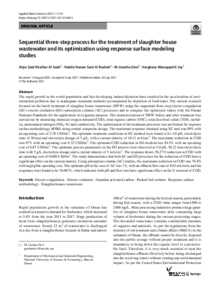Document
Sequential three-step process for the treatment of slaughter house wastewater and its optimization using response surface modeling studies.
Identifier
DOI: 10.1007/s13201-021-01469-3
Source
Applied Water Science. v. 11, 8, 139
Contributors
Devi, M. Geetha., Author
Joy, Varghese Manappallil., Author
Country
Germany.
Publisher
Springer Science and Business Media Deutschland GmbH.
Gregorian
2021-08-01
Language
English
English abstract
The rapid growth in the world population and fast developing industrialization have resulted in the acceleration of environmental pollution due to inadequate treatment methods accompanied by depletion of freshwater. The current research focused on the batch treatment of slaughter house wastewater (SWW) using the sequential three-step electro-coagulation (EC)–electro-oxidation (EO)–adsorption column (AC) processes and to compare the optimized values with the Omani National Standards for the application in irrigation purpose. The characterization of SWW before and after treatment was carried out by measuring chemical oxygen demand (COD), total organic carbon (TOC), total dissolved solids (TDS), turbidity, ammoniacal nitrogen (NH4–N) and conductivity. The optimization of the treatment processes was performed by response surface methodology (RSM) using central composite design. The maximum response obtained using EC unit was 99% with an operating cost of 2.78 USD/m3. The optimum treatment conditions in EC method were found to be 4.0 pH, electrolysis time of 30 min and electrolyte dosage of 5 g/L, with a current density of 18.11 mA/cm2. The maximum reduction in COD was 97% with an operating cost 0.32 USD/m3. The optimum COD reduction in EO method was 84.5% with an operating cost of 6.87 USD/m3. The optimum process parameters in the EO process were observed at 5.0 pH, 56.22 min electrolysis time with 5 g/L electrolyte dosage and a current density of 5 mA/cm2. The response shows 56.27% reduction in COD with an operating cost of 0.088 USD/m3. The study demonstrates that both EC and EO processes for the reduction of COD have a significant effect on the current density. Using adsorption column (AC) studies, the maximum reduction in COD was 76.8% with negligible operating cost. The optimum pH in the case of AC was 7.5, with an effluent flow rate of 8.63 mL/min, and the responses were found to be 76.067%, which indicates both pH and flow rate have significant effect on the % removal of COD.
ISSN
2190-5487
Category
Journal articles

